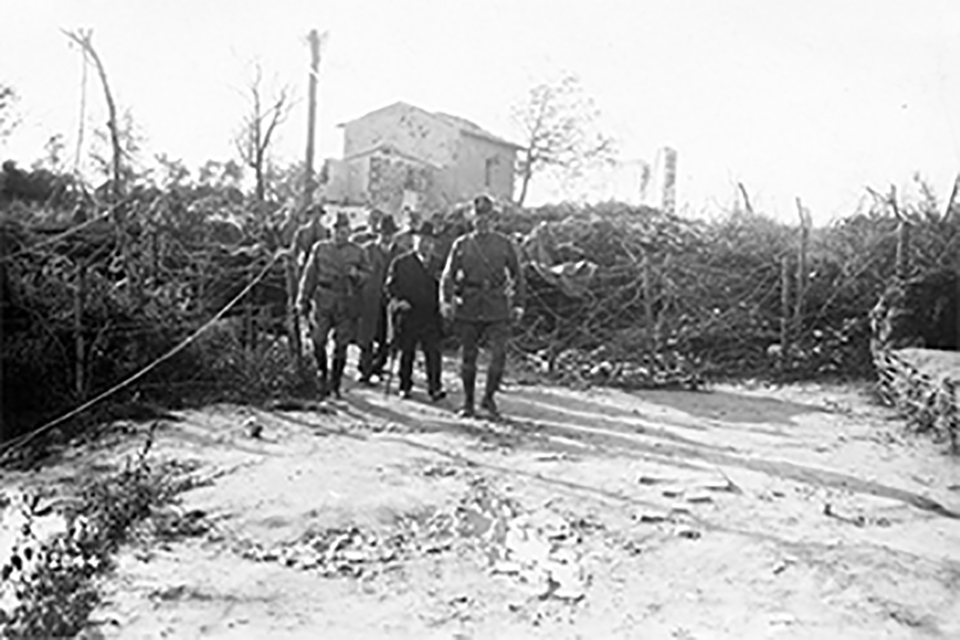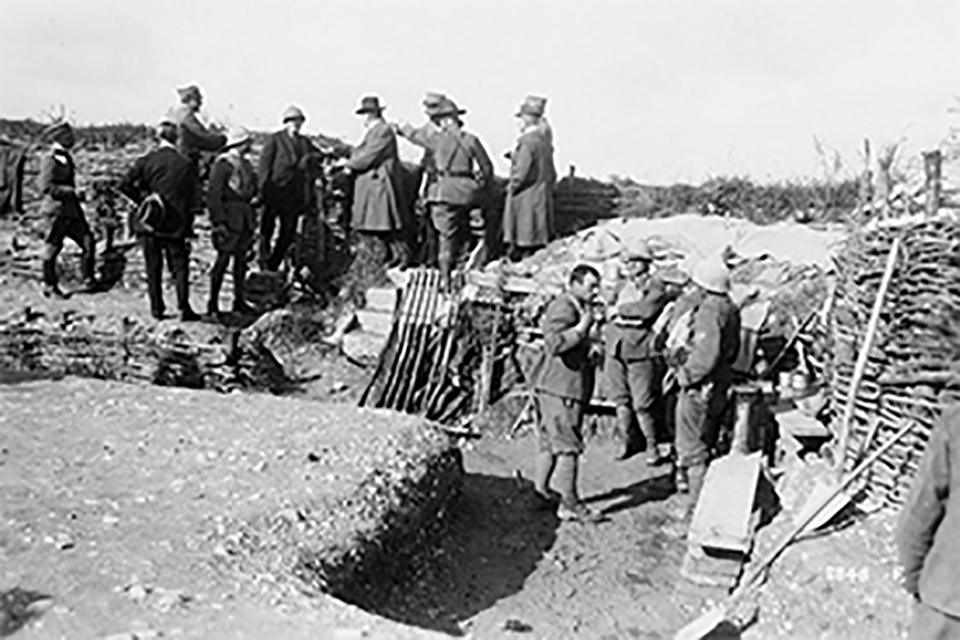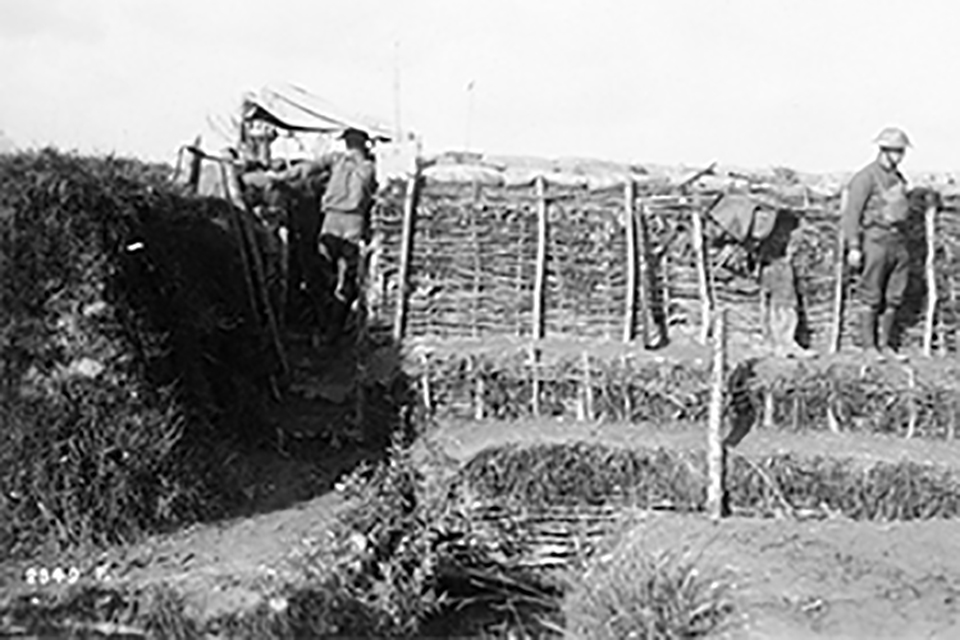4000 men and 125 officers under the command of Colonel William Wallace.

The USA entered the war on 6 April 1917 as a result of the sinking of the Lusitania ship, which had made America’s enormous production capacity available to the Allied front, thus marking a turning point in the stagnant conflict, which was going heavily in favour of the Central Powers. However, for the most part, the US war effort was directed towards the western front that appeared to be in greater difficulty than the secondary Italian front, which was more stable. In 1917, the only US approach to the Italian front was the night bombing training of US pilots, which took place at a school in Foggia (where more than 400 pilots were trained, most of which were then sent to the western front) and the training of about 50 pilots at the Scuola Idrovolanti (seaplane school) of Marina di Bolsena, in the spring of 1918. This led to the subsequent creation of an independent squadron made up of US personnel only (in place of the Italian 263rd squadron) and, on 24 July 1918, a U.S. Naval Air Station was opened at the seaplane base of Porto Corsini (but with Italian seaplanes and materials). In this phase, the presence of volunteers was also recorded (the Young Poets, which included Ernest Hemingway and other American poets and writers among their ranks): they were employed as ambulance drivers and as staff supporting the Red Cross, in provisioning and at the so-called “Soldier's Houses” run by the YMCA.
No involvement was foreseen on the land front in Italy. On 31 January 1918, as a result of the Battle of Caporetto, the United States Department of War established a US mission to Italy under the command of General Eben Swift, in order to check not only the progress of the war on that front but also the morale of the Italian population after such a heavy defeat. The assignment was signed on 15 February 1918, with huge opposition from the interallied command in Paris, which considered the US involvement on the front in France as an absolute priority and made it clear that there would be no US military involvement on the Italian front. On 20 February, the Department of War confirmed to the US Command in Paris that troops would not be sent to the Italian front.
As a result of the pressure from Italian emigrants’ lobbies in the USA, the awareness that the Italian front was strategically important in engaging the Central Powers, and also thanks to lengthy negotiations (General Giardino, on 18 April 1917, and Minister Orlando, later, requested at least one division, i.e. about 40,000 men), on 14 May 1918 General Pershing, head of the US mission to Europe, arranged for a regiment to be sent to Italy. At the request of Italy, it had to comprise as many soldiers of non-Italian origin as possible (so that the troops would not be mistaken for Italians disguised as Americans); they had to be trained and housed by Italians, but food had to be paid by the Americans. Their activities would have been purely propaganda-oriented and aimed at persuading the Austrians that the US forces were heavily deployed on the Italian front, thus helping to raise the morale of our fellow countrymen.
On 26 June, a regiment was chosen, which at the time awaited training in Donnemarie, in France, 90 km from Paris: the 332nd Infantry Regiment of the 83rd Division, composed mainly of soldiers from the State of Ohio and who had trained at Camp Sherman; along with it, the medical unit (the 331st Infantry Regiment) for a total of 4,000 men and 125 officers under the command of Colonel William Wallace. The departure was scheduled for 25 July 1918, with arrival in Villafranca di Verona on the following day.
In the meantime, the British command in Italy, both on the initiative of the commander in the field, Lord Cavan, and of the head of the mission, General Redcliffe, also requested the presence of at least two US divisions on the Italian front to join the British forces in order to form two armies: one under British command and the other under US command, under the orders of General Swift (with whom Lord Cavan had addressed the subject at the beginning of July). Pershing gave a rather annoyed reply, reaffirming that the US involvement in Italy would have only concerned one regiment (with the request that the Italian Government be clearly informed of this) and that the British should not be involved in this matter (telegram of 18 July). General Swift was immediately summoned back to Versailles and replaced by General Charles G. Treat. Again, in September 1918, during a meeting with Pershing, General Diaz demanded that at least 20 or 25 divisions be sent to the Italian front. His request was rejected, with no response from the US command.
The regiment carried out its propaganda duties right from the outset: in the Italian leg of the journey, the train stopped at each main station and was welcomed by a jubilant crowd, along with a band and political personalities. The regiment was greeted heartily at each stop. Upon arriving in Villafranca di Verona (between 26 and 29 July), after the usual celebrations, the regiment was at first deployed to four different sites, but since Colonel Wallace was not pleased with this arrangement, it was regrouped in a camp near Valeggio (Mantua). Here, the regiment began training, led by the Arditi Company under the command of Major Allegretti. The training period was marked by a tragic accident that occurred on 13 September: a mortar grenade exploded during the drill in a crowded trench. One officer and four soldiers were killed and more than 40 were wounded and, due to this event, some of them (including a lieutenant colonel) decided to end their military career.
At the same time, the propaganda campaign began: the troops attended every event or party held in the area, including an award ceremony of American pilots in the presence of King Victor Emmanuel III of Italy, and a trip to Rome with the band of the regiment. At the beginning of September, the second battalion had been sent to preside over an area of the front along the Piave River, but without ever fighting. In early October, the rest of the regiment joined the second battalion and was then transferred near Treviso, settling at Villa Angelica in Lancenigo. On the night of their arrival, the city was bombarded by the Austrian air force, which had presumably found out about the US military presence in the area. On 14 October, they were transferred to the city of Treviso. During this period, the troops continued to take part in a number of events, military decoration ceremonies and any other event of public interest. The daily forced marches also began: each battalion was observed, in full equipment, across the entire front line of the River Piave, in different places and dressed in a different way each time (in the morning with coats and helmets, in the afternoon with hats and jackets, and so on). They had to give the impression that there was a heavy US military presence at the front. And this strategy succeeded so well that several Austrian officers that had been made captive in Codroipo were convinced that they had come across the vanguard of an army of at least 300,000 Americans.
The regiment took part in the war operations on 31 October, crossing the Piave River at the Grave di Papadopoli, in the rear of the British regiments. It crossed Vazzola, stayed in Gaiarine and, in the afternoon of 3 November, it arrived on the banks of the Tagliamento River, in Ponte della Delizia. Here, they were contacted by an Austrian colonel who had received news that the armistice had been signed at Villa Giusti, which would have taken effect from 3.30pm on the next day, and therefore asked Commander Wallace to cease fire. But Colonel Wallace did not trust the Austrian, and so he refused. The attack on the opposite bank of the Tagliamento River, manned by the Austrians with numerous machine guns, was launched at 5am the next day and, after a couple of hours, the regiment had broken through the enemy lines and began heading towards Codroipo. The losses amounted to a dead corporal (Charles S. Kell of company G) and seven wounded. In Codroipo, in the afternoon, they received news of the Armistice. The regiment was ordered to advance as much as possible, since the new Italian borders would be drawn according to how far the troops had advanced in the territory. On 12 November, the regiment arrived in Cormons (the first town of the Austro-Hungarian Empire) in a forced march, reaching Pozzuoli, Lovario and Ipplis. In the meantime, the second battalion had been sent to Kotor in order to control tensions between the Serbs and Montenegrins, whereas the third battalion had been assigned to Rijeka for police duties. The rest of the regiment returned to Treviso on 24 November. On 11 February 1919, the regiment, which had been reunited with the second and third battalion, was transferred to Genoa from where it left for the USA on 29 March 1919. The regiment was then disbanded between 2 and 3 May 1919 at Camp Sherman and all its members were discharged from the army. At the end of the conflict, the losses amounted to one dead and seven wounded in combat, five dead and forty injured in training, plus about forty dead due to illness (mainly due to the so-called “Spanish flu”).


